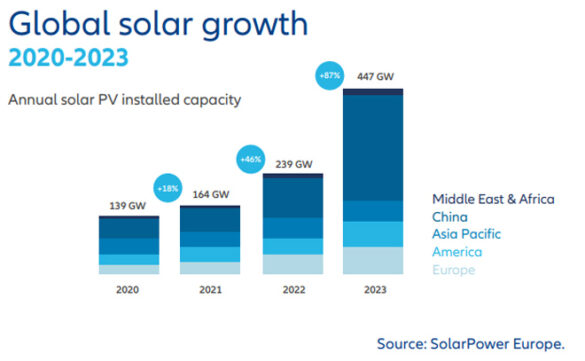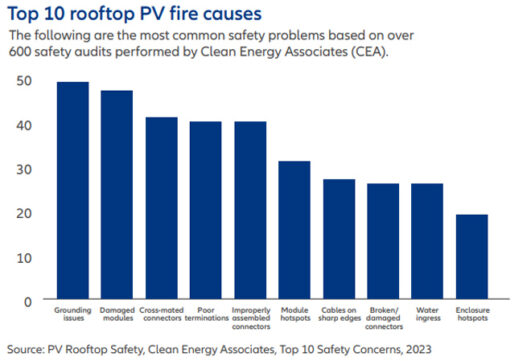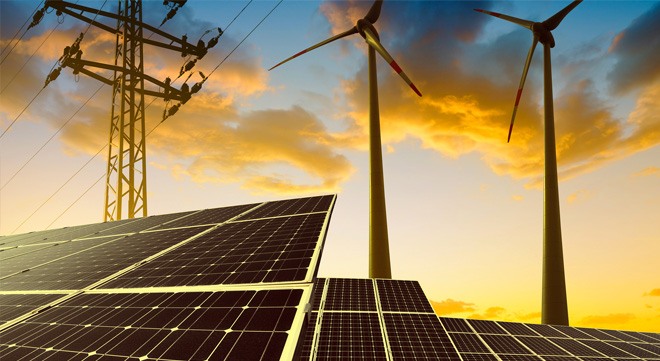To borrow from Spider-Man, with great solar power comes great responsibility. The photovoltaic (PV) industry has grown rapidly into a major sector, with projections indicating even more significant expansion on the horizon. But, as the industry advances, new risks are beginning to emerge, requiring effective mitigating strategies.
Investment in solar PV is projected to exceed $500 billion this year, surpassing all other generation technologies combined. Solar PV is expected to account for roughly half of the increase in global electricity demand through 2025.
In 2023, global solar installations surged by 87% compared to the previous year, with China leading the charge by installing 57% of the world’s solar capacity. There are now 33 countries where solar generation constitutes more than 10% of the energy mix, including Chile (20%), Australia (17%), and the Netherlands (17%). The state of California, boasting a 28% share, is the world’s fifth-largest economy.

According to SolarPower Europe, by 2028, annual installations could reach 1 terawatt (TW) of solar capacity, although the industry says that unlocking financing and energy system flexibility is crucial to achieving this goal.
Daniel Schroeder, senior risk engineer at Allianz Commercial, highlights that many governments are announcing carbon commitments and setting net-zero goals to facilitate the energy transition.
“So, we know clients face increasing pressures from regulators and stakeholders to revisit their energy strategies and improve their environmental performance,” he says.
An Emerging Risk Trend Talk report from Allianz Commercial notes that the installation of solar PV panels introduces various risks that must be managed to harness this energy source.
Schroeder says: “The rapid rise of installed systems on rooftops, for example, has created complex challenges for both fire services and the code enforcement community. Several high-profile fires have occurred in commercial buildings with roof-mounted solar PV systems.”
What are the main risks?
The PV industry faces a variety of risks associated with its installations, which differ based on whether the systems are ground-mounted or roof-mounted.
Allianz says roof-mounted PV modules can serve as ignition sources and increase combustible loading, impacting fire growth and spread, as well as the ability of firefighters to manage the situation.
Although natural elements such as hail and wind result in claims, Allianz says fire remains the primary concern. “A roof fire can result in a total loss of the building below and business interruption,” the report states.
Ground-mounted installations, commonly used in larger-scale PV farms, also face specific challenges, particularly from vegetation.
“Although vegetation can reduce the impact of erosion in a large flood event, it can also increase the spread of fire, which could damage a greater number of PV modules and support frames,” Allianz notes.
Moreover, ground-mounted systems are at risk of wind damage, particularly when supporting frames lack tracking ability or if the foundations are compromised by erosion because of inadequate storm-water management.
From an insurance risk-management perspective, Allianz ranks the preferred locations for PV panels in the following order: ground-mounted, separate parking structures such as carports, and roof-mounted systems.
Fire
PV panels installed on rooftops can act as ignition sources, increasing the chances of fire outbreaks.
The report states: “Like any other electrical installation, PV systems are subject to electrical faults, such as arc faults, short circuits, ground faults, and reverse currents. These faults and other system failures – including cable insulation breakdowns, rupture of a module, and faulty connections – can result in ‘hot spots’ that can ignite combustible material in their vicinity.”
The report also points out that incorrectly installed or defective components have caused several fires related to PV systems.
“In addition, numerous fires have started in roof-mounted PV installations due to DC arcs caused by inadequate ground fault protection.”
A 2023 assessment identified common safety concerns for rooftop PV systems, including grounding issues, damaged modules, cross-mated connectors, poor terminations, and improperly assembled connectors.

Another important issue is the combustibility of roof structures, which cannot be fully protected by safety measures. Many parts of PV systems are made from plastics, which increase the fire risk on a roof.
The report warns that “the installation of PV systems on commercial and industrial buildings with combustible roofs – including those insulated with combustible polystyrene, polyurethane, or polyisocyanurate – is discouraged, as a fire on such a roof could easily result in a total loss of the building, as well as present significant risk to human life.”
Installing PV systems on green roofs – layers of vegetation on rooftops – is becoming more popular. Although these roofs can provide shade and help cool the air, the report warns that “in some cases, the vegetation or even the substrate could support a fire spread on the roof if no proper precautions are taken”.
Firefighting can also be challenging because of the placement of PV panels. The report notes that these installations often lie beyond a building’s fixed fire protection and detection systems, leading to delays in detecting and responding to fires.
Allianz states, “as PV systems are not usually equipped with property protection or monitoring systems like sprinklers or detection systems, firefighters need to be able to access the roof quickly and safely to tackle any blaze”.
When firefighters arrive at a burning building, one of their first tasks is to shut down the power supply. However, with PV systems, this can be difficult. The inverters may remain charged, sending electricity back to the panels and allowing them to generate power even in low light.
“In fact, the DC cables between the PVs and inverters remain under direct voltage even if the main panel has been cut. Fire crews are exposed to the risk of electric shock in the presence of high voltage and current.”
To ensure safety, Allianz emphasises the importance of safely disconnecting PV panels during a fire. This process must reduce currents and voltages to a level that minimises the risk to responders.
Additionally, “firefighters also face potential risk of exposure to fumes from burning plastic materials, as well as the danger of falling debris”.
Hazards, challenges, and loss prevention
Besides fire, the report highlights several risks tied to rooftop PV installations, including natural hazards, roof overloading, theft, vandalism, and liability concerns.
For natural hazards, the report notes that roof-mounted PV systems are vulnerable to hail, wind, snow, and lightning, particularly as climate change drives more extreme weather. “Around the world, project development is pushing developers to use locations that are highly exposed to natural catastrophe.”
Hail has become the top cause of solar project losses, with insurance claims totalling $5 million to $80 million, and one Texas hailstorm in 2022 causing damage of more than $300m, Allianz notes.
Windstorms can also dislodge PV components, creating airborne debris, while larger, thinner panels tend to have weaker wind resistance. Heavy snow and rain accumulation can damage panels, while flooding erodes the supports of ground-mounted systems.
Roof overloading is another concern. Solar panels add 10kg to 20kg per square metre, and “not all roof structures are designed to withstand additional loads”, the report warns. Extra weight can lead to leaks, sagging, or even roof collapse over time.
Theft and vandalism of PV systems are on the rise, often resulting in major financial losses. “Thieves are increasingly using modern technology such as Google Earth and drones, to scope out targets,” sometimes stealing entire panels or extracting valuable materials such as copper.
Liability risks are also significant. Although solar PV is generally reliable, potential issues include installation quality, contracting challenges, and third-party concerns, particularly if a leased roof or ground hosts a PV system.
“Third-party liability risks are also posed by the presence and use in solar panels of PFAS and cadmium telluride, due to their toxicity and potential to pollute the environment,” the report states.
In the report, Allianz Risk Consulting lists risk mitigation and loss prevention measures. Read the full report for details.



